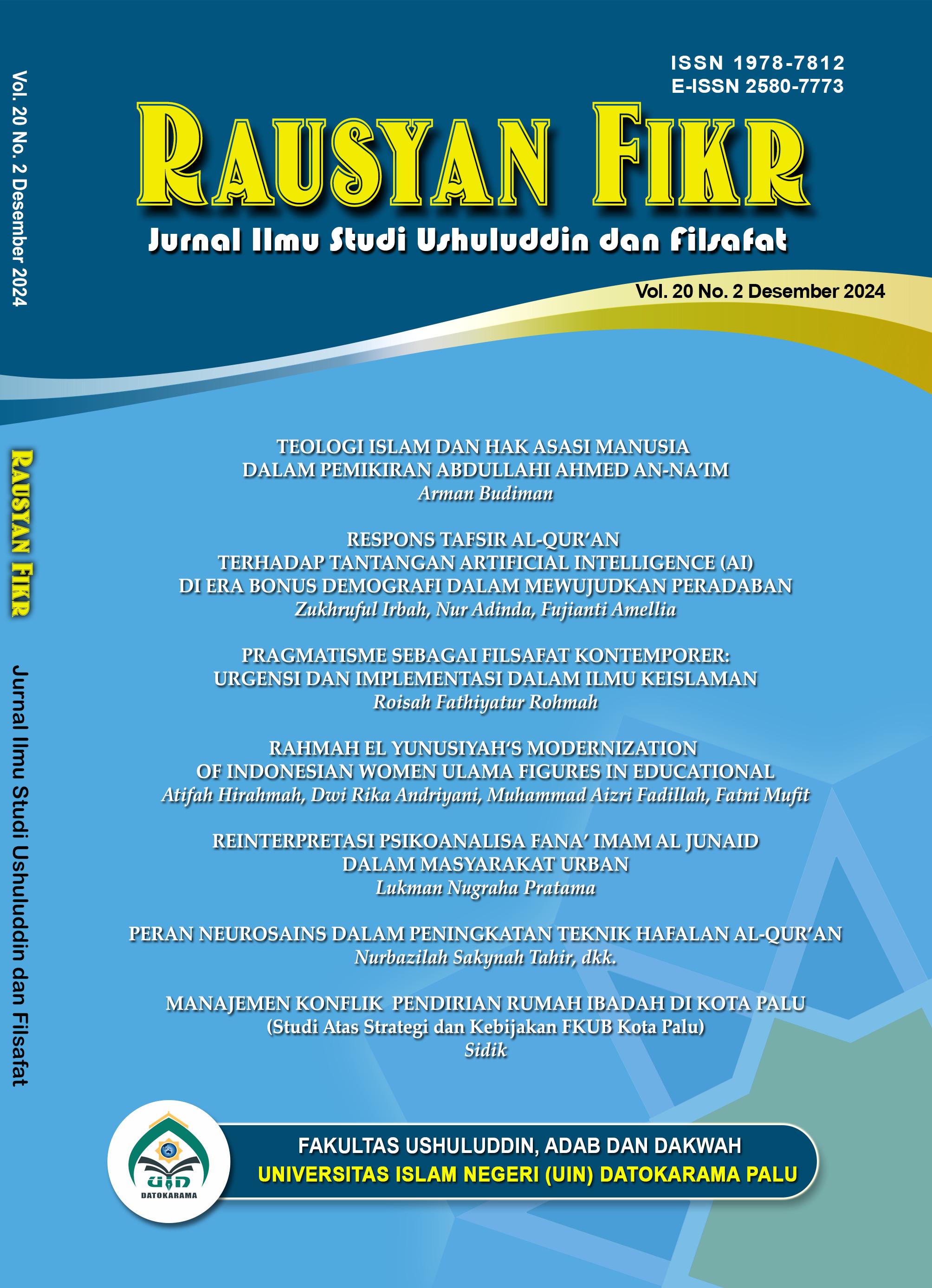PERAN NEUROSAINS DALAM PENINGKATAN TEKNIK HAFALAN AL-QUR’AN
Abstract
This study discusses the role of neuroscience in Qur'an memorization learning and its relationship with Qur'an memorization techniques. However, most memorizers pay little attention to and do not understand the benefits of neuroscience in memorizing the Qur'an. In addition, the memorization techniques currently used focus solely on the learning aspect without being linked to neuroscience. Therefore, this study aims to identify brain functions and memory processes in Qur'an memorization learning and examine the relationship between neuroscience and Qur'an memorization techniques. To achieve these objectives, this study employs a literature review methodology to answer the research questions. The results of the study indicate that there is a relationship between neuroscience and Qur'an memorization techniques. By understanding the connection between neuroscience and Qur'an memorization, memorizers can improve the quality of their memorization. This study provides insight into the importance of understanding brain functions and memory processes for Quran memorizers. Memorization techniques can be adjusted based on neuroscience knowledge to enhance the effectiveness and quality of memorization.
References
Abdullah, M., Abdullah, A. H., Rosman, A. S., & Illias, M. F. (2015). Strategi awal menghafaz al Quran menurut Abu Dzar Al-Qalamuni. In The 5th Annual International Quranic Conference (pp. 1–16).
Achmad, Z. A., Rukajat, A., & Wahyudin, U. R. (2022). Pengaruh Metode Talaqqi terhadap Peningkatan Kemampuan Menghafal Al-Qur’an Peserta Didik Kelas Al-Qur’an TPQ Darussalam. Al-Afkar, Journal for Islamic Studies, 282–301.
Ahmad Fikri Luqoni, et al. (2024). Paradigma Integrasi Keilmuan dalam Tafsir Salman. Jurnal Penelitian dan Pengabdian Masyarakat, 3(12), 4847–4857 (4848).
Ali, N. (2024). Penerapan Model Pembelajaran Sentra Tahfidz Sebagai Strategi Efektif Dalam Pengembangan Kemampuan Menghafal Anak Usia Dini Di TK Al- Kautsar Jagakarsa Jakarta Selatan.
Amalia, U. R., Rasyid, A. M., & Asikin, I. (2024). Penerapan Metode Tasmi’ Al-Qur’an dalam Meningkatkan Kualitas Hafalan Santri. Tadib Jurnal Pendidikan Islam, 13(1), 169–176.
Arini, J., & Widawarsih, W. W. (2021). Strategi dan Metode Menghafal Al-Qur'an di Pondok Tahfidz Darul Itqon Lombok Timur. Jurnal Penelitian Keislaman, 17(2), 170–190.
Aziz, S. N. S., Baharudin, L., & Syahirah, N. I. (2024). Perbandingan Sikap Pelajar Terhadap Hafazan Al-Quran: Kajian di Sekolah Menengah Kebangsaan Agama Putrajaya. Qiraat: Jurnal Al-Quran dan isu-isu kontemporari, 7(1), 10–18.
Gracia, A., Puspojudho, S., & Yudha, R. P. (2023). Hubungan Kualitas Tidur dan Memori pada Anak Usia Dini: Pendekatan Formatif Orde Kedua. Jurnal Obsesi: Jurnal Pendidikan Anak Usia Dini, 7(3), 3013–3024. https://doi.org/10.31004/obsesi.v7i3.4554
Habibullah, H., & Septantiningtyas, N. (2024). Meningkatkan Daya Ingat Dalam Menghafal Imriti Melalui At-Takrar. Jurnal Educatio FKIP UNMA, 10(3).
Jackson, E., Leitão, S., Claessen, M., & Boyes, M. (2020). Working, declarative, and procedural memory in children with developmental language disorder. Journal of Speech, Language, and Hearing Research, 63(12), 4162–4178.
Khotimah, H., Sa’dijah, C., Rofiki, I., & Latifah, E. R. A. (2024). Proses Berpikir Siswa dalam Menyelesaikan Masalah Bilangan Berpangkat dan Bentuk Akar Berdasarkan Teori Pemrosesan Informasi. MATHEdunesa, 13(2), 499–513.
Kosslyn, S. M. (2006). The case for mental imagery. Oxford Psychology Series, 39.
Kumar, A. A. (2021). Semantic memory: A review of methods, models, and current challenges. Psychonomic Bulletin & Review, 28(1), 40–80.
Lorenc, E. S., Mallett, R., & Lewis-Peacock, J. A. (2021). Distraction in visual working memory: Resistance is not futile. rends in Cognitive Sciences, 25(3), 228–239.
Moktar, M. S., & Sharif, M. F. B. (2021). Kaedah Talaqqi Musyafahah dalam Tilawah Al-Quran: Method of Talaqqi Musyafahah in Reciting Al-Quran. MANU Jurnal Pusat Penataran Ilmu dan Bahasa, 32(1).
Morris, R., Amaral, D. G., Bliss, T., Duff, K., & O'Keefe, J. (Eds.). (2024). The hippocampus book. Oxford University Press.
Mustafa, N. M., & Basri, M. (2014). Perbandingan kaedah hafazan al-Quran tradisional dan moden: Satu kajian awal. Proceeding of The Social Sciences Research ICSSR 2014, 827–834.
Nurhayati, F., & Hilmi, I. (2024). Efektivitas Pembekalan Kosakata Harian terhadap Kemampuan Berbicara Santri: Penelitian di Kelas 8 Tsanawiyah Pesantren Persis 67 Benda Kota Tasikmalaya. JURNAL SYNTAX IMPERATIF: Jurnal Ilmu Sosial dan Pendidikan, 5(5), 1011–1026.
Rahim, M. M. A., Sidek, M. S. M., & Abd Hamid, M. H. (2023). Factors Analysis of Learning Hifz Al-Qur'an Towards the Practice of Tahriri Al-Qur'an: Analisis Faktor Pembelajaran Hifz Al-Quran terhadap Amalan Tahriri Al-Quran AL-MAKRIFAH Journal of Knowledge and Learning in Islamic Tradition and Culture, 1(1), 26–35.
Risma, I., Loka, N., & Amzana, N. (2024). Penerapan Metode Tabarok dalam Meningkatkan Hafalan Al-Qur'an di Madrasah Ibtidaiyah Syuharatul Islam Gelumbang. Istinbath, 16(2).
Saladin, Kenneth. (2011). Human anatomy (3rd ed.). McGraw Hill. p. 416. ISBN 978-0-07-122207-5.
Salihin, M. S., Pisol, M. I. M., Yahaya, M., & Abd Hamid, M. H. (2022). Pengukuhan Hafazan Al-Quran: Cabaran & Penyelesaian. QIRAAT: Jurnal Al-Quran dan isu-isu kontemporari, 5(2), 34–40.
Schacter, D. L., & Addis, D. R. (2007). The cognitive neuroscience of constructive memory: remembering the past and imagining the future. Philosophical Transactions of the Royal Society of London. Series B, Biological Sciences, 362(1481), 773–86.
Senova, S., Fomenko, A., Gondard, E., & Lozano, A. M. (2020). Anatomy and function of the fornix in the context of its potential as a therapeutic target. Journal of Neurology, Neurosurgery & Psychiatry, 91(5), 547–559.
Septadina, I., Jannah, E., & Suryani, P. (2021). The Effect of Reciting Holy Qur'an Toward Short-Term Memory. Jurnal Aisyah: Jurnal Ilmu Kesehatan, 6(3), 565–568. https://doi.org/10.30604/jika.v6i3.515
Shan, L., Chen, Q., Yu, R., Gao, C., Liu, L., Guo, T., & Chen, H. (2023). A sensory memory processing system with multi-wavelength synaptic-polychromatic light emission for multi-modal information recognition. Nature Communications, 14(1), 2648.
Shulman, Robert G. (2013). Neuroscience: A Multidisciplinary, Multilevel Field. Brain Imaging: What it Can (and Cannot) Tell Us About Consciousness. Oxford University Press. p. 59. ISBN 9780199838721.
Tahir, N. S., Husain, M. Z., Naqibah, K., Yussop, Y., & Yahya, S. (2024). Hubungkait Antara Neurosains dan Kaedah Hafazan Al-Qur’an Siyaq dan Peranannya dalam Peningkatan Prestasi Hafazan. Jurnal Tafsere, 12(1), 1–25.
UMMAR, A. M. B. (2021). Tahap Keberkesanan Tidur Petang (Qaylulah) Terhadap Hafazan Pelajar Tahfiz di Khalifah Model School Secondary. (Tesis Sarjana).
Van Houdt, F. T., & Morris, R. G. M. (2024). Long-term potentiation and memory: Past, present, and future. Nature Reviews Neuroscience, 25(3), 116–129.
















